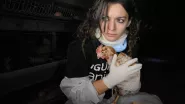The English photographer Anastasia Taylor-Lind arrived in Kiev on the 1st of February 2014. Maidan Nezalezhnosti, Independence Square, (known also as Maidan), was occupied by protesters. The anger of the Ukrainian people against their government became stronger, especially after President Viktor Janukovyč’s refusal to sign an agreement with the European Union. Instead, he preferred a stronger alliance with Vladimir Putin. Maidan was surrounded by police loyal to the Government.
Rather than choosing a ‘traditional’ photojournalistic way of documenting the protest, Anastasia Taylor-Lind opted for a more conceptual and personal method of representing the ‘before' and ‘after' of the so-called Battle of Maidan. Setting up a photographic studio in Hrushevskoho Street, inside the barricade of Maidan, she shot film. Using two cameras, a series of portraits of the anti-government protestors against the uniform background of a black curtain manifested. Each portrait is characterized by a different homemade body armor: military jackets, weapons, helmets, on which sometimes a cross appeared as a kind of sign of protection. Some of the men in the series had their faces covered; while some looked at the camera with a straight gaze. This set of images is alternated with a series of portraits of women, taken mostly after the most violent day of Maidan - the 20th of February 2014. During the three months of protest, over 100 people died. As Anastasia Taylor-Lind said in a 2014 TED talk: ‘These two sets of pictures don't make much sense without each other'.
If the men showed determination and resolution before the battle,the women showed a quiet sadness after it. Their pale faces, highlighted by the black scenery, reflect a special candor. If the men carried signs of fighting, the women were holding - with a maternal gesture - flowers, as a sign of mourning. Looking at the women’s faces, I thought about a story that I read: a woman in her 50s entered the Hotel Ukraina, a luxury hotel on Independence Square, which was turned into a hospital during the Maidan days. She was there looking for her husband, who had just lost his life. She could have been one of Anastasia’s stories. Anastasia Taylor-Lind said she cried with almost all the women who came to her studio. The strength of this series of portraits lies in the capacity of the photographer to visually summarise the beginning and the effects of a conflict. The men and women whom Anastasia Taylor-Lind met and portrayed are from the same world, but their roles are on opposite sides of the story. As she said: 'Men fight most wars, and women mourn them. If the men showed the ideal of the warrior, then the women showed the implications of such violence'. In this way, the meaning of Portraits from the Black Square goes beyond Maidan and can be applied to any conflict that involves the loss of lives of civilians, the separation of families and people’s despair. Anastasia Taylor-Lind, with sharpness and intensity, captured the nature of war in a beautiful and powerful series of images.












